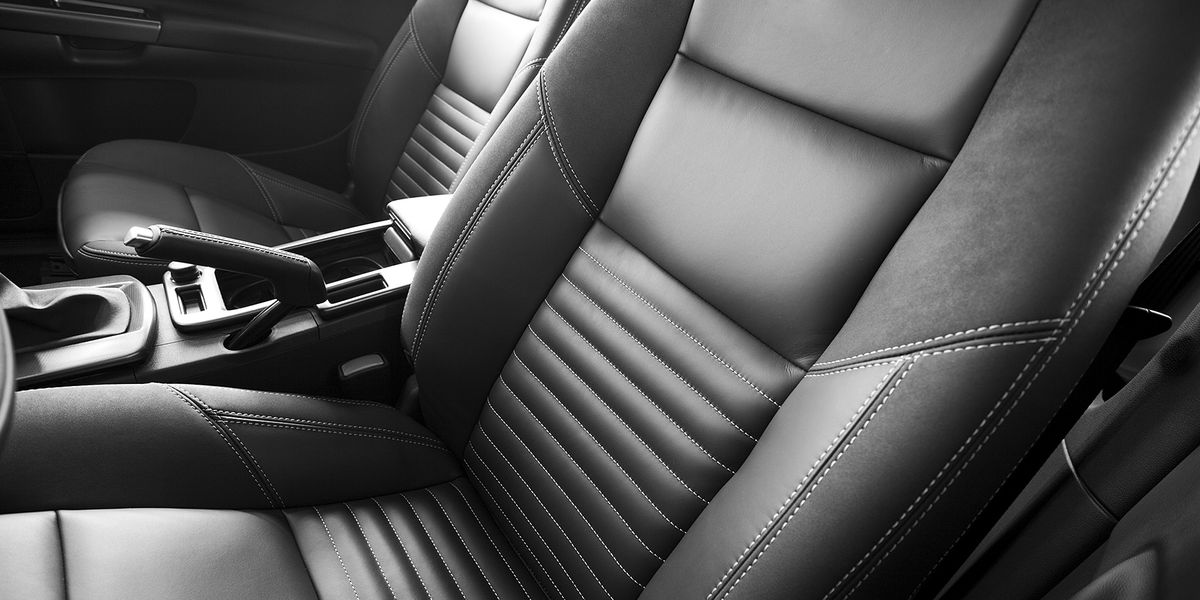How to Clean Leather Car Seats

Okay, so you spent the extra money on those plush leather seats, but now you have cracker crumbs and half a kid’s meal all over them. So, now you’re probably wondering, how am I going to clean that without damaging the seats? Or, what can I use to clean up this mess? While we don’t have magic wands to help you clean your seats, we do have the steps and tips that can get your seats cleaned up in no time.
What You Need
Using the right tools and materials can help you maintain your leather seats and keep them looking sleek and plush for years to come. And the best part is you don’t need to shell out loads of money for premium tools and top-of-the-line materials. You can find many of these items at your local auto retail shop or favorite online retailer. Here are some tools and products you can consider to help clean your car’s leather seats:
Step by Step: Cleaning Leather Car Seats
Tackling your leather seats on your own can be kind of intimidating, especially if it’s the first time you’re attempting to clean your seats. Fear not because there are a few easy steps you can take to help you prepare your seats for the royal treatment. Here are some simple steps you can follow to clean your seats without leaving scratches or dirt behind:
1. Remove Obstacles and Large Debris
If you have a child or pet, you likely have large items such as a car or booster seat installed in your vehicle. Removing these items, as well as any trash or other large obstacles, can help you efficiently clean your seats. This can also help you see and tackle any dirt or grime, that your kids might have left behind from their afternoon snack. This also gives you the chance to clean these items before installing them in your vehicle again. Doing this can help you maintain the clean look and feel of your leather seats for longer.
2. Vacuum the Seats
Vacuuming your seats and surrounding area can help you pick up those pesky crumbs and sprinkles of dirt. If you have a brush attachment for your vacuum, you can use this to clean your seats without gouging or scratching your seats. Ensure you get between all the little cracks and crevices to pick up all the dirt you can. If there is still dirt and dust crammed into the seat’s different crevices, you can use a cloth to get them out.
3. Test Your Cleaning Solution
Before applying your leather cleaning solution to your seats, it’s a good idea to test your solution on a small hidden part of your seats. This is especially important if this is the first time you’re using a new cleaning solution, as it can prevent you from accidentally ruining or staining your leather seats. Some reactions to look out for include any fizzing or melting, which indicates that you need to stop using that cleaner immediately.
When choosing a new cleaning solution, consider reviewing your owner’s manual as there might be specific cleaner recommendations from your vehicle’s manufacturer. If you’re cleaning MB-Tex material, it’s important to use a gentle cleaning solution rather than a harsh leather cleaner to prevent any damage or stains to your seating upholstery.
4. Clean Off Additional Grime
The vacuum is great for picking up any loose debris, but there might still be some grime left behind. If this is the case, you can use a microfiber towel that’s been sprayed with the cleaner to get rid of this grime. This is great for any of those sticky residues left behind from your kids’ spilled juice or melted gummy snacks, and there is a type of deep-rooted satisfaction you get when these sticky spots are gone. Once you’re done cleaning off the surface layer of dirt and grime, you’re ready to start deep cleaning your seats.
5. Apply a Cleaning Solution
Once you’ve tested a spot on your vehicle’s seats, you can apply the cleaning solution to the rest of your seats. Using a soft-bristled brush, you can work the cleaning solution to a lather. This can help break down tough stains and dirt in the upholstery and creases. When applying the cleaner, ensure you only apply enough to clean the seat versus saturating the material. It’s also a good idea to work in small sections at a time to prevent discoloration or staining from the cleaning solution.
If your seats have holes, scratches, tears, or other perforations, apply the cleaning solution with caution. You might consider applying the cleaner to a microfiber towel versus directly to the seat material to prevent additional damage to your seats. When working the solution to a lather, apply gentle pressure to clean the surface. Moving the bristled brush in circular motions can help you gently remove tough stains and dirt without damage.
6. Wipe the Seat With a Damp Towel
Now that the seats are clean, you can wipe away the cleaning solution from the seats. Starting with a slightly damp towel, wipe away the excess cleaning solution from the seats. Using a damp towel helps to pick up any dirt or grime you may have missed during cleaning, which prevents the debris from making its way to your car’s floor. Now that you’re thinking about your vehicle’s floor, you might also consider looking into floor mats, so cleanup is a breeze when crumbs from your seats ultimately make their way to your floor.
7. Dry Seats With a Microfiber Towel
After completing your initial wipe down, you can follow up with a dry microfiber towel. This helps to remove any excess moisture from the seat’s surface, which can help prevent any mold or mildew from building up. Ensure you wipe the seats until they are completely dry to also help prevent the seats from wrinkling or cracking.
8. Apply a Leather Conditioner
It’s a good idea to follow up your cleaning routine with a leather conditioner. Some sources suggest cleaning them once every three months, but most seats don’t need attention that frequently. Many conditioner manufacturers often include a recommendation about how often to use their product on your seats. A leather conditioner can help improve the longevity of your seats because it can help ward off any cracks, tears, or stains.
If this is the first time you’ve used the conditioner, ensure you test an inconspicuous spot on your seats before applying it to the rest of your seats. Once tested, you can apply the leather conditioner to your seats. When applying the conditioner, ensure you use small circular motions to work the conditioner into the seat. After applying the conditioner, let it sit and air dry for a minimum of one hour before going on your next adventure.
Leather Cleaning Tips
There are many tips and tricks that can help you maintain the plush look and feel of your leather seats. Here are some tips and recommendations to consider:
How to Use Leather Cleaning Products
Each store-bought product often has explanatory steps to guide you through using their product. Many products recommend first cleaning the surface with a vacuum before applying a cleaning solution. Gently working the cleaner into your seats is most effective in removing stains and dirt from your seats. Reviewing the cleaner’s specific instructions can help ensure you apply the cleaning product correctly.
If you’re still unsure of how to use the leather cleaning product or don’t want to risk damaging your seats, you might consider taking your vehicle to a detailing professional. These professionals can help expertly clean and condition your leather seats with fewer chances of damaging or staining your seats. These professionals also often have access to premium tools and solutions to give your seats their best clean and shine.
How to Choose Leather Cleaning Products
When choosing a leather cleaning product, there are many things to look for in a cleaner. First, it’s important to consider the condition of your seats. Existing damage and wear can affect the cleaner’s effectiveness, so evaluating this information beforehand can ensure you choose the right cleaner. Some items to look for in a cleaner include:
The cleaner is free from harsh chemicals, which can cause damage to your seat.The cleaning product is in a spray form that you can easily apply and wipe away.The leather cleaner is compatible with different leather colors and textures.The product is designed for new and old leather.The formula used for the product is nontoxic or has no fragrance, which can stain your seats.
Using conditioners that have petroleum or waxes can cause buildup on your plush leather seats. These finishes can also result in the dulling of the seat’s leather material. When evaluating your leather conditioner, look for natural ingredients in the ingredients list.
How to Keep Leather Clean Longer
Using a leather conditioner that has sunscreen or some form of sun protection can help fortify your vehicle’s seats against harmful UV rays. Having microfiber towels readily available in your vehicle also allows you to immediately clean up any spills, which can help prevent any stains or grime from building up. This can also prevent any material discoloration from occurring when spills happen. Regularly vacuuming your vehicle with a soft brush attachment can also help you get ahead of any dirt buildup on your seats, which can keep you from continuously doing a deep clean on your seats.
How Often to Use Leather Conditioner
There is no set recommendation about how often you should use a leather conditioner on your seats. Reflecting on how often you use your vehicle, where you park it, and who is often along for the ride can help you determine how often to use leather conditioner. If you use your vehicle often, park your vehicle in direct sunlight, or if you have a pet or children, you might use leather conditioner more often to prevent any wear and tear on your seats.
Consider Using Seat Covers
If you often have passengers or animals in your vehicle, you might consider installing seat covers over your leather seats to protect them from additional wear or tear. Seat covers are also a good idea if you’re consistently hauling stuff around in your back seats. There are so many seat covers to choose from, so it’s easy to find designs and materials that work for you. Want to find a sleek black design? Sure, there are plenty of those. Want ’90s flowers or cartoon-esque flames instead? No judgment here, because there are plenty of those available too.
Consult Your Car Dealership or Original Owner
If you’re uncertain about the previous care and treatment of your leather seats, it’s a good idea to consult the original owner or dealership in which you purchased the vehicle. This gives you the opportunity to learn if they have redyed your seats in the past, which can influence how you clean your seats. Certain cleaning solutions and leather conditioners might react to redyed seats, so learning this information beforehand can help prevent any accidental damage or staining to your seats.
This content is created and maintained by a third party, and imported onto this page to help users provide their email addresses. You may be able to find more information about this and similar content at piano.io




